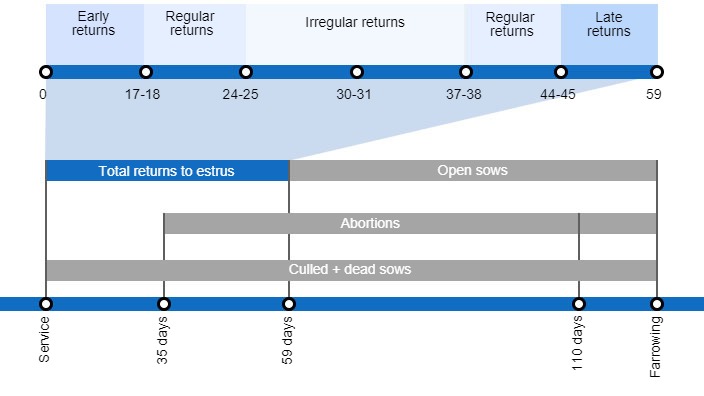If we have a farrowing rate less than 85%, and total returns are above 8%, the next step is to ask at what point are the returns occurring.
The returns are classified into the following types according to the time at which they take place:

Early returns to estrus:
The sow comes into heat before 18 days post-service.
Under normal conditions these account for a very small percentage of the matings < 0.5%.
Regular returns to estrus:
Happen days 18 - 24 and 38 - 44 post-service. A sow has a regular return (maintaining the normal duration of an estrous cycle: 18-24 days, or its multiples) when fertilization of the eggs has failed or when all fertilized embryos have been lost within the first half of the estrous cycle (<10-12 days).
Under normal conditions these should make up a very small percentage of the matings < 5%.
Irregular returns to estrus:
Returns happening 25 - 37 days post-service. A sow has an irregular return to estrus (abnormally long estrous cycle) when all the embryos have been lost (< 35 days of gestation) and are reabsorbed, or when only 5 or fewer embryos remain at 10 days of gestation.
Under normal conditions these should account for a very small percentage of the matings < 3%. Irregular returns are generally considered to be a problem when they account for over 30% of the total returns, but it should be noted that when the total returns are very low, irregular returns will account for a higher percentage of the total; this is considered normal, as the problem sows are those that return (we are not up against a problem).
Late returns to estrus:
Returns between 45 - 59 days post-service.
Under normal conditions these should make up a very small percentage of the matings < 1%.
When the percent of sows returning to estrus is greater than 8% of the sows serviced, we should find out at what point post-service they occur. Use the buttons above or the flowchart to continue troubleshooting the returns to estrus, or to access other parts of the tool.






